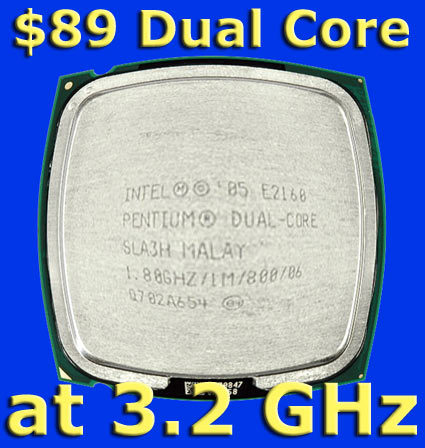$89 Pentium Dual Core that Runs at 3.2 GHz
An Overclocker's Dream: Pentium Dual Core Runs 3.2 GHz

Last year we wrote about a low-cost dual core processor that could be overclocked from 2.66 GHz up to an incredible 4.1 GHz. It was the good old 90 nm Smithfield core based Pentium D 805, which delivered an incredible overclocking margin and amazing performance for a moderate $130. While this processor is still available at some places, a new overclocking champion is emerging. Intel's current low-budget processor, called the Pentium Dual Core, is based on the Core 2 microarchitecture, which means that it is energy efficient and fast, despite its low clock speeds Compare Prices on Pentium Dual Core Processors. It offers an even larger overclocking margin of up to 80%, and comes at a price that is almost ridiculously low: how does $89 sound for a boxed processor with cooler?
Both processor makers try to streamline their manufacturing processes by creating multiple processor models based on a single silicon design that is highly scalable. While AMD still has various types of silicon, Intel already outputs mobile, desktop and server processors based on the Core 2 microarchitecture from unified production lines. Whether a silicon chip will become a Xeon, Core 2 Duo or a Pentium Dual Core depends on production yields as well as on customer demand. The final product is typically determined towards the very end of the production process (bonding and packaging). Intel even creates its quad core processors by integrating two dual core processor dies into one CPU package for Sockets 775 (Core 2) or 771 (Xeon 5000). AMD, while being late with its quad core Barcelona, is quick in criticizing this methodology as not resulting in true quad core processors. However, quad core performance is there, and that's what counts at the end of the day.
The Pentium Dual Core, which we found to be an excellence choice for overclockers on a low budget, is based on the popular Core 2 architecture. In fact, the processor cores are the same, but the CPU comes with only 1 MB L2 cache instead of 2 MB or even 4 MB. In addition, some features, such as Intel's Virtualization Technology (VT) are disabled. The result is a castrated Core 2 Duo processor, using the small cache size and limited to 1.6 to 2.0 GHz clock speed at FSB800 system speed. However, we found the mid-range model Pentium Dual Core E2160 at 1.8 GHz to be extremely overclockable: we could run 3.2 GHz on standard air cooling using the boxed cooler.
However, this overclocking venture requires a relatively fashionable motherboard, as all Core 2 processors (including the Pentium Dual Core) require a voltage regulator unit that complies to the VRM11 spec. This is necessary to handle rapidly and frequently changing current levels due to power saving mechanisms inside modern processors, which may even shut down entire processing units or cache segments when not needed. Older VRMs may not be able to provide stable power under such scenarios, although the CPU's bus protocol hasn't been changed since the introduction of the Pentium 4 processor. Have a look at your motherboard manual or at the support page on the manufacturer's website; at best, all you will need is a BIOS update.
Join our discussion on this topic
Stay On the Cutting Edge: Get the Tom's Hardware Newsletter
Get Tom's Hardware's best news and in-depth reviews, straight to your inbox.
Current page: An Overclocker's Dream: Pentium Dual Core Runs 3.2 GHz
Next Page Chose Your Components With Care-
ripwind Yep - It was this very article that caused me to buy mine, along with a G92 8800GTS. My E2160 has been running @ 3.2GHZ with the stock cooler for almost 3.5 years. I'm only now considering an upgrade.Reply
Both that processor and that video card have scaled so well over the years that I'm still able to run what I want at 1920x1080 with reasonable settings. -
presto84 I've just bought a second hand motherboard for university and it came with this CPU onboard. Remembered this article so had to look to check it was the same chip. The board has an Intel P945 chipset and supports up to 1333mhz according to the website so might be worth giving this a go.Reply -
Noodletoe One of my all-time favorite Toms articles - used it to OC my E2180 to 3.0ghz 4 years ago and it's still running strong as my guest computer. I was just looking to upgrade the CPU to a E-6550 I found for cheap, but after re-reading this article I think I'll just leave it alone :)Reply